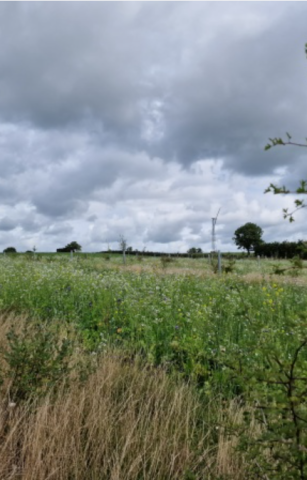One speaker, Andy Gray from Elston Farm in Devon, shared how he is trialling growing maize with a permanent living mulch, which is part of an Innovative Farmers field lab trial. To do this, he is establishing a living mulch of dwarf white clover and using a strip till to drill maize into it.
Why grow a living mulch with maize?
Speaking in the webinar, Andy explained that he decided to experiment with growing a permanent living mulch under maize for several reasons, which were:
- He wanted a way to continually feed the soil biology, which establishing a permanent cover could achieve
- The year-round cover provided by the clover living mulch could also protect the soil from erosion and nearby water courses from nutrient-rich run-off
- He had given up ploughing with the exception of when growing maize, so wanted to find an alternative way of establishing maize with less soil disturbance
- Growing under maize seemed an obvious use of living mulches because the gap between maize is more than that of cereals, so the presence of the clover living mulch could help reduce the weed burden within the maize crop
- The clover could provide nitrogen to the maize crop, reducing the quantity of additional fertiliser needed
- His farm is south facing and on good maize growing land
- The farm is surrounded by dairy farmers who want to buy maize, so it makes sense to grow the crop as it can be sold locally
- The clover could provide grazing immediately after the maize harvest without needing to wait for a cover crop to establish
Minimising competition
It is well-known that maize does not cope well with competition. In the webinar, Andy shared that Rothamsted tried to grow a clover living mulch under maize a decade ago and had an 80% yield suppression, but past failures have not put him off from giving it a go. “Talking to people, it transpires that this isn’t an original idea, the Swiss adopted the system on a large scale because of the run-off into their lakes, so we shouldn’t just give up because it doesn’t work once,” he said.
To minimise competition for the maize, Andy is using an uncompetitive variety of white clover. “We established it using an interrow drill into maize last year - at normal forage drill width - and it hasn’t joined up across the width of the drill yet at nine months later,” he said. “I have a suspicion that by using a non-competitive clover we might overcome the problems that set back the Rothamsted trial.”
Andy explained that the idea is for the strip till system to disrupt the non-competitive white clover for long enough for maize to establish and get away. He is also trialling suppressing the clover with glyphosate and also grazing it with sheep immediately prior to drilling. “We’re trying to maintain continual cover, but reduce it just before drilling, and hope the maize gets dominant enough to suppress it,” he said.
Establishing maize with a strip till system
“Maize has lazy roots, it doesn’t do much from point of view of putting its roots down,” said Andy. He explains that he has set up the strip tilling system with a subsoiling foot on the front, which breaks up the ground to give the roots an open structure to grow into. It then has discs to do the strip till itself and pipes to put in either liquid or solid nitrogen fertilisers, to prepare for the maize to go in afterwards.
“The idea is to strip till first, then use precision drill to put maize in exactly the same slot as the strip till has gone through,” he said.
Economic benefits
Andy explained that a team in Wisconsin has successfully trialed growing maize with a permanent living mulch, and estimated that the clover provides 40-80% of the maize’s nitrogen requirement. As the maize matures, the clover loses access to sunlight and drops leaves which act as a source of nitrogen to the growing maize. The presence of the clover also gives the soil a better structure for spreading slurries or FYM in the winter. “Of course, the American’s have the advantage of being able to use glyphosate resilient maize, which isn’t an option here,” he added.
Andy shared that he set off on the trial not knowing what rewards may or may not be available via the Sustainable Farming Incentive (SFI). “With a companion crop, the payment on SFI would be about £57 per hectare.
“If we were to put another species in with the clover over winter, something that would either die in the frost or be easily suppressed, we could potentially get another payment of about £120 per hectare by having that winter cover crop.
“Sometimes you set off on a journey, then find you’ve got other ways of offsetting the potential suppressed yield from competition,” he added.
Find out more
Andy’s example was just one of three covered in the webinar on putting regenerative farming theory into practice. Speaking in the same webinar, Tom Martin from Village Farm near Peterborough, shared how he has experimented with using companion cropping to combat cabbage stem flea beetle. In addition to managing the pest, he has noticed an allelopathic effect of the buckwheat on blackgrass in the following crop, which was particularly obvious following an unintentional trial when a strip of field was sown without the companion mix.
In addition, Andy Barr from East Lenham Farm in Kent spoke about the various transitions through machinery that he has undergone since moving to direct drilling from 2010 onwards. While direct drilling has presented certain challenges, he shared how he has been able to make it work on his farm.
To hear more from Andy Barr, Tom Martin or Andy Gray, login to the members’ section of the website to watch the webinar in full. Not a member yet? Find out which RASE membership option suits you here.


